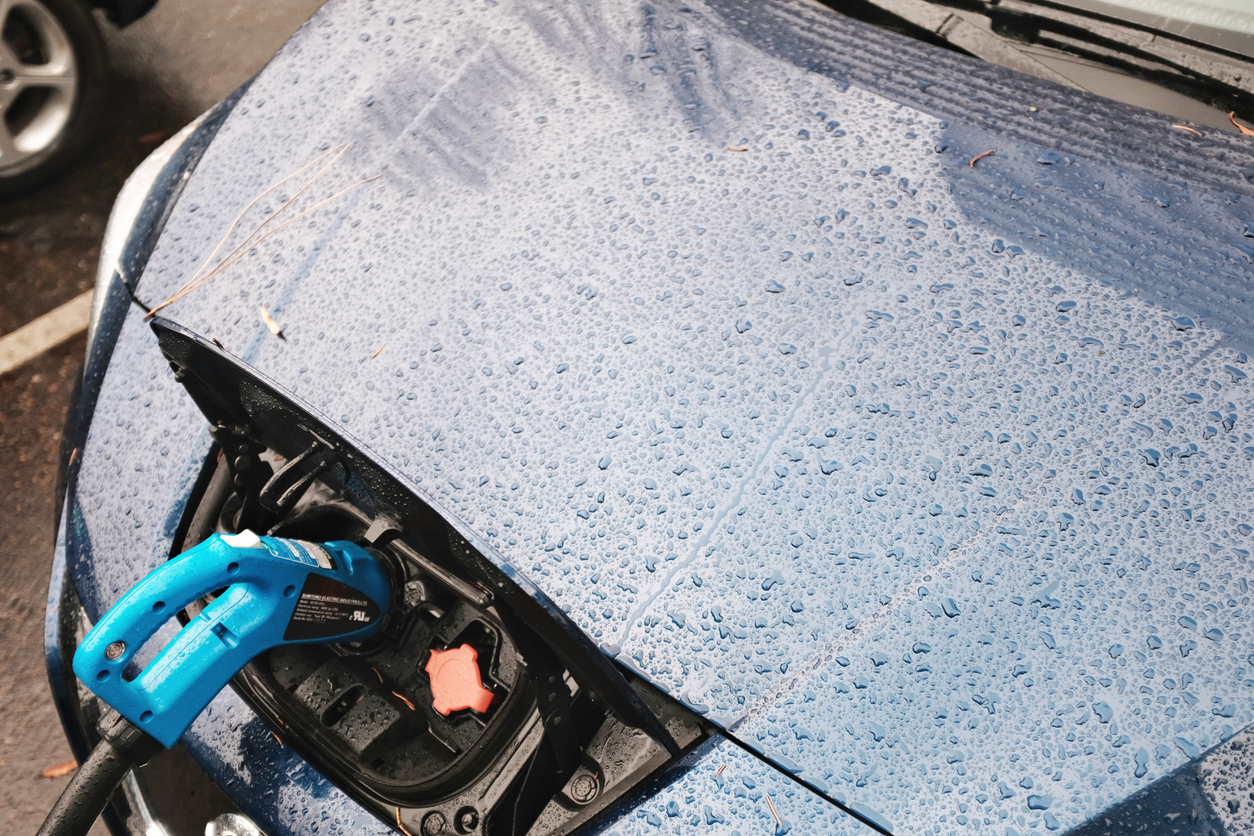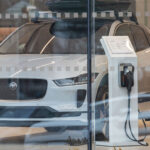TL;DR
Most everyone has learned, seemingly from toddlerhood, that electricity and water do not mix. So, what about an EV? It’s electric, right? Is it safe to plug or unplug your EV in the rain? Can you take your EV through a car wash? Can you drive an EV through a puddle? In short, do EVs and water mix? The answer to all of these questions is an unequivocal yes.
The Nitty Gritty of Mixing Water and EVs
Simply put, water easily conducts electricity. To be precise, pure distilled water will not conduct electricity; rather, the impurities in water make it conductive. Just a pinch of salt in distilled water is all it takes. Tap water, rainwater, or really any type except for pure distilled water has enough impurities to make it a good (or even great) conductor of electricity. The human body, being ~60% water, also happens to be a good conductor of electricity.
So how can an EV, which can potentially store enough energy to power a large home for two days, be deemed safe enough for public use? The key to understanding the answer is knowing that in order for electricity to flow, it must make a complete circuit from the battery’s cathode (positive terminal), through a conductor, back to the battery’s anode (negative terminal), and then through the battery’s electrolyte solution to the cathode. This description is a bit different for the AC outlet in your home, but the principle is the same – a complete circuit from the origin via a conductor back to the origin source is required.
The exception is the rapid electrostatic discharge you experience when you walk across a carpet and grab a door handle or pet your dog. This discussion ignores that type of electron flow, because an EV’s potential for rapid electrostatic discharge is the same as a gas-powered car.
In the case of any situation involving the risk of electrocution, your body must complete the circuit. In an EV, that would mean becoming part of the electrical path from the battery’s cathode to the anode. On the charger side of the EV, it means becoming part of the electrical path between the car’s charge port and the EVSE (or DCFC). This basic fact is true regardless of whether it is Death Valley bone-dry out, you’re driving the car through a car wash, or you’re unplugging your car while standing in a puddle of water. If everything is working as designed, this scenario just isn’t possible.
But what about when things aren’t working as designed? What then? It turns out that this becomes a difficult question to answer, but let’s try anyway.
Let’s frame this discussion by looking at three scenarios:
- Unplugging an EV in the rain
- Driving an EV through a car wash
- The risks following a collision in an EV
Unplugging an EV in the Rain
First, let’s talk about what happens when you plug in and unplug your car when things work as designed.
The electrical connectors (pins) inside a J1772, NACS, or CCS handle are staggered so the first pin that makes contact as the car is plugged in is the ground wire (it’s also the last pin to disconnect when unplugging). This is important because it sets the reference voltage to ground. As in the literal ground you are standing on, because the Earth also happens to be a good conductor, and in this case, the ground is 0 volts.

The pin descriptions of a J1772 plug. Tesla’s NACS conforms to the same electrical convention, albeit within a different mechanical plug. Even the CCS Type 1 combo plug uses the same convention, though with the addition of two new pins for the DC current (Line 1 and Line 2 are absent in the CCS plug as they are not needed). Image credit: Wikimedia.
The next thing that happens when you plug in your car and the latch clicks into place is that the proximity pin connects the EVSE (or DCFC) to the car – so now it “knows” it’s plugged in. This also uses the good old-fashioned 12V lead-acid battery that was in your grandma’s first car. When you unplug the car and first press the button on the handle of the plug, this connection is broken, and any charging is stopped before the plug can be removed from the car.
Lastly, the car will communicate with the EVSE (or DCFC) using the control pin (again using the 12V line). This communication is done to ensure that ground is established, both the EVSE (or DCFC) and car state that they are in good health, and then the car uses this line to control the incoming power. Remember – the car controls the power delivered, up to the maximum of the EVSE (or DCFC) it is plugged into.
Once all connections are made and system health checks report back that the car successfully communicates with the EVSE (or DCFC), then and only then are the main relays closed that allow the high power to flow to the battery.
Hopefully, this description was simple enough to make it useful to the layperson but also complete enough that I won’t get hate mail from EVSE engineers. I think it is crucial to establish everything that has to happen correctly before power can flow to the high-voltage battery.
Aside from all of the protections in place, how can things go wrong and potentially put a person at risk? I tried writing out some detailed ways this could happen first, but after reading it, I found myself laughing out loud. It’s pretty far-fetched and convoluted. Maybe a summary is best:
- To be at risk, a person has to “suddenly” be inserted into the already completed circuit, because remember: power doesn’t start to flow until several layers of safety checks are passed, and the power flow is stopped the moment the control line goes silent.
- The only way water comes into play with a “sudden insertion” into the already completed circuit is if the circuit is simultaneously altered to flow through the ground, and there is protection in place against that.
If this sudden insertion into the circuit sounds a bit sketchy, that’s because it is. It portends something dramatic and traumatic, say Monty Python’s 16-ton weight suddenly dropping as you are unplugging the car. I’m not saying it couldn’t happen; it’s just that the 16-ton weight might be the larger worry.
If you recall the Ice Bucket Challenge circa 2015, one EVSE manufacturer used the opportunity to demonstrate how waterproof their EVSE was. If unplugging your car in the rain is still a concern, buy a JuiceBox.
Driving an EV Through a Car Wash
Most people ask this question not out of concern for personal safety but for fear of damaging the car. Being in a car wash is really no different than driving in the rain. And yes, the car has been engineered to drive in the rain.
Let’s address the personal safety issue briefly. To be at risk of rain (or car wash) from the electrical energy stored in an EV, you need to become part of the circuit, and we are dealing with the 16-ton weight scenario again. Furthermore, for the conductivity of water to be a factor, you either need to have the windows down or be driving the car while also standing on the ground.
What about the car then? The car is well-engineered against water. There are plenty of examples on YouTube about Nissan Leafs plowing through water over two feet deep, Jaguars driving through the surf, and even a guy who bought a $125k Model S Plaid to use as a submarine just to try and win internet notoriety. In summary, the electrical bits are well-sealed against water.
The Risks Following a Collision in an EV
To minimize the risks involving water and EVs following a collision, manufacturers install pyrotechnic devices, called a pyro fuse, that are designed to sever high-voltage lines and isolate the battery. These work on the same principle as the airbags in your car, but instead of inflating the bag, the pyrotechnic charge propels a blade severing the high-power line.
The risks to both occupants and rescue crew following a collision are small, but not zero, and standing in a puddle of water could actually increase that risk in some circumstances because it does increase conductivity to ground. Luckily, rescue professionals are trained in the special knowledge required to rescue passengers in an EV after a traumatic accident.
If you’re one of the passengers in said tragic accident, and you survive, you might consider waiting for expert removal if you are ambulatory. Otherwise, stay clear of any puddles your car is resting in without touching the car’s metal parts – just in case the pyrofuse didn’t blow.
Fortunately, the probability of everything lining up just so is vanishingly small, though not zero. But the probability is lower than a fire or explosion following a similarly tragic accident in your last gas-powered car.








0 Comments